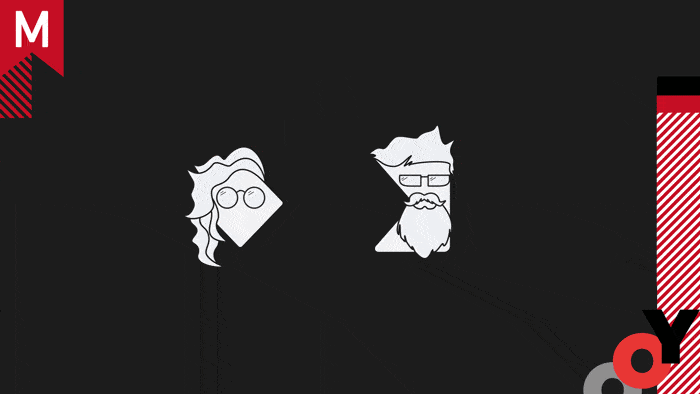
Between the Keyframes is a new podcast/vidcast uniting industry legends Austin Shaw and Erin Sarofsky. The pair take on hot topics in an effortless back and forth as they candidly discuss the crazy world of Motion Design, from their biggest mistakes to their ample frustrations to the unique insights that will tee up the next generation.
I sat down with Austin and Erin to chat about the motivations behind the new show and give our readers a taste of life Between the Keyframes.
Episode 1: The History of Now lays the foundation for the rest of the show by discussing the roots of Motion Design. Let’s also start at the beginning. How did you two meet?
ERIN: You know we’ve been trying to work that out. I think we met in 2006 or 2007. I was at Superfad in New York, and the owner/executive producer brought Austin into freelance on some jobs that I was running, and it was just perfect. I was thinking, this guy can concept, he can animate, and he was remote, which was really strange back then. He was like the OG of remote work. I’m trying to remember, but we would communicate mostly over AIM [AOL’s instant messenger]. It was a very modern working relationship for the time.
But you know, Austin’s always been a little different. He’s an amazing artist, and yet he always had aspirations to teach. He had a master’s degree – which is rare in our field – and so did I, so I think we connected on another level, plus we’re both from the east coast. Then he went down to SCAD to teach. And so, now I had an inside scoop on all the fresh talent coming up. He would also freelance for us at Sarofsky here and there. And I don’t know, it just became a really great work relationship, but there was always friendship at its core.
AUSTIN: Yeah, we met while I was freelancing, and, I don’t know, there are some people you just click with, and you can talk to easily. It was always fun working with Erin because she is the kind of creative director who I felt would make my work better, helped me elevate, she’d always give me great direction. Plus, we won some pitches together, and that’s always fun.
When I went down to teach at SCAD, being able to bring Erin in as a speaker to come and lead some workshops was awesome. To have a strong female lead was always super inspirational for our students. Erin was actually the first person I interviewed for my Design for Motion textbook. It was a super friendly interview. She kind of walked me through what kind of questions I should ask. Now I’ve done probably dozens of interviews, but it started there, which is really cool.
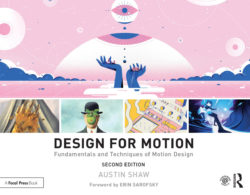
Why start a podcast/vidcast?
ERIN: Well, right when the pandemic hit, everything slowed down, and everyone started freaking out. But within a month, we were all super busy again. It went from panic in one direction to panic in the other.
I’d just commissioned Austin to come and help on one of our projects, so we were speaking on the phone every day. At that time, I was having trouble relating to some of the younger artists in the studio… So, because of his background, I would interrogate him about the “kids these days.” We started talking about this gap from graduating to the working world that just isn’t being taught.
AUSTIN: Yeah, exactly, the bridge from an educational environment to a professional one.
ERIN: It’s hard to describe, but the transition from an academic environment to a professional one can be challenging and not as intuitive or obvious as you might expect. It can be especially challenging in a more casual studio environment, where the culture is more open than in a corporate job.
We would talk about the gap in understanding the role of producers, to professionalism, to addressing feedback, to the actual rigors of our production schedules. And in those conversations, a lot of things emerged. There’s a lot of podcasts about amazing people doing incredible things. But a lot of work has to happen before you’re a superstar producing this kind of content. And it’s not just keyframing and doing beautiful work.
Also, a lot of projects are team-driven. So, we wanted to explore how to work and be your best self within that team structure too, and we found that those are traits rooted in soft skills.
AUSTIN: Hard skill plus soft skills, yeah. COVID was definitely a big inspiration too. I was now teaching remotely, so I had to learn words like synchronous and asynchronous. After a month of teaching these classes, I started bringing in guests to talk to the students, and after one of these interviews, one of the students was like, “you should do a podcast.” I’m kind of camera shy, so if they’d have suggested it pre-COVID, I’d have said it was crazy. But I had to get over myself really quickly if I was going to teach effectively. I remember right after I texted Erin: one of my students suggested I do a podcast, and she was like: I’ll do a podcast with you.
What are you hoping to achieve?
AUSTIN: I’ve noticed in the classroom over the years that when you hear people tell stories in their own words, it kind of humanizes it. That makes things seem a little more accessible or achievable for students who tend to put people on a pedestal. We’re saying to the students that these professionals are just like you, they’re just a little older and a little more experienced. But they were in your seat at one point; they were art and/or design students.
Why “Between the Keyframes?”
AUSTIN: Erin came up with the name. It was so cool. It could mean a lot of different things: How we manage and interpret the change between keyframes, life keyframes, like when you start something, and there’s a big change in your life.
ERIN: I liked it as a kind of “Between Two Ferns,” which makes me laugh because it’s art. These are our ferns. It’s about life that happens in between the actual craft of it.
You do touch on craft, though. There’s a repeated episode called “Reel Time. Reel Talk,” what’s the premise?
ERIN: We have people submit their reels to us, and we might chop it up and change the order and give tricks and tips on how to make it better.
AUSTIN: It’s something I’ve done for a lot of years with my students. They bring their demo reel, we drop it in After Effects, and we do an edit on the spot; in doing that, we can share some best practices and best approaches to make a strong first impression.
What sort of tips do you give them?
ERIN: Well, for example, people tend to put their best work at the end of their reels because they want to finish strong. But unless you start strong, the viewer is never going to get to the end. You really want to start strong.
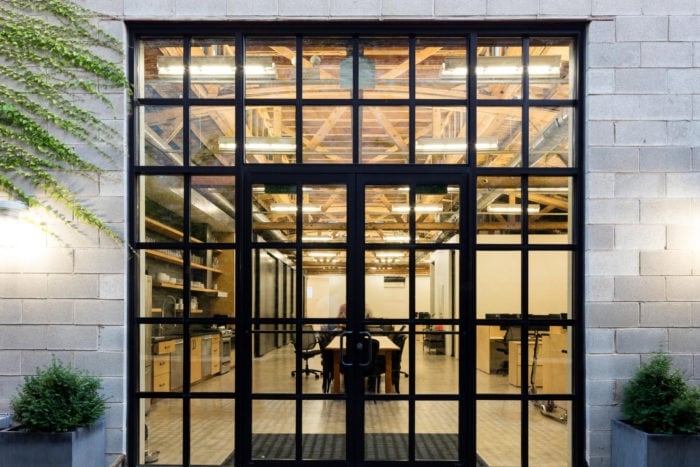
Sarofsky Studio.
Do you ever advise people to do shorter reels and take out the stuff that’s not up to the standard of the rest?
AUSTIN: Absolutely!
ERIN: Yes.
AUSTIN: We always say less is more, (so long as whatever’s there is good). The montage is not meant to tell the whole story anyway. It’s meant to pique someone’s interest and make them hungry for more; go to your website or schedule an interview.
What are some of the most unforgivable mistakes you see in people’s reels?
ERIN: Emailing me, the owner of Sarofsky, and starting with “Hello Imaginary Forces” or “Hello Elastic.” That’s unforgivable. Dude, pay attention to what you’re doing. Write a nice short email. Mention something we’ve done before. “I love your work on Captain America.” It doesn’t take much to customize it and show you know our work.
AUSTIN: The lack of curation, which goes back to the idea of taking out the weaker bits. It creates confusion, and it makes you question their taste.
ERIN: Yeah, we talk about that a lot. And artists have to pay attention to typography.
Something we should talk about as an episode is where is the line between animation and Motion Design? For me, at least as it pertains to reels, that line becomes composition and typography. You have to take a type class if you want to be a Motion Designer. It’s brutal when you see beautiful animation and then abysmal typography.
AUSTIN: Just about every commercial project has type, and we’re seeing more and more creative captioning as opposed to just subtitles. So, if you can demonstrate you can do it, it’s a really employable skill. Whenever I’m reviewing a student’s demo reel, I’m looking to see if they have enough demonstrations of not only moving type but type that’s set well. And if they don’t, then it’s like, okay, that’s what we need to do. We need to either layout some type, do some fun animation, or get a logotype animated and include that in the reel.
Episode 2: Work From Home. This is a hot topic in all industries right now. What’s it been like adapting for business and education?
ERIN: In general, we’ve seen that people are much more productive working remotely through COVID. I think the pandemic caused such an immediate shift; we just had to trust everybody to go on doing what they were doing. That said, there is something missing from a company culture perspective that is undeniable.
It was important for me to have an aspirational space, you know. So, I spent all this time and money building out a beautiful studio. And part of it becomes people living up to working in such an amazing space with all of these other amazing people. Without being together, the team can kind of miss the context of what we’re putting out in the world. For example, we just did all the type for Suicide Squad.
We’re doing really big stuff. If everybody were in the studio, even the people not touching the work would be able to influence it and feel a part of it. Even though the team only needed a handful people, everybody at the company would feel invested in it. And now, working remote, some people might not even see the final product before it goes out.
That’s why you come to a Sarofsky, especially as a younger artist, so you can be in the loop with some of that work; even if you’re not actually the one working on it, you’re still seeing it, influencing it, and asking those artists questions about it.
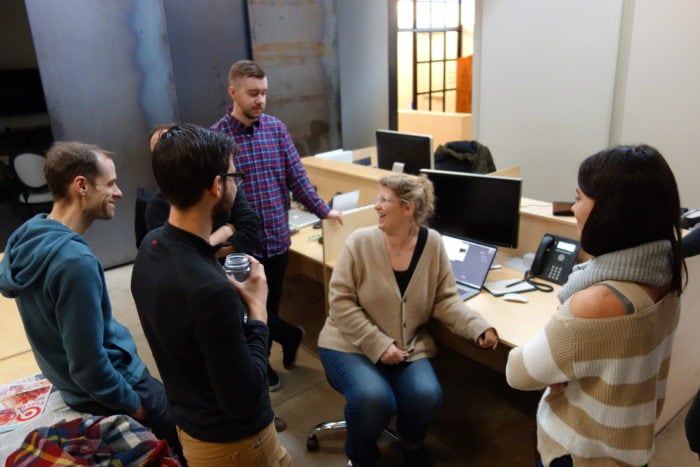
Erin and the team at Sarofsky Labs.
AUSTIN: For me, teaching was a big adaptation, having to learn really quickly how to pre-record videos, getting some recording software, etc. There were a lot of crash courses. I told myself that I just had to do the best I could and figure it out. But I’d also have so many other things to think about, like being able to create some kind of culture in a zoom environment.
As for the alumni I’ve talked to, whose first jobs were during COVID, whether it’s an internship or new hire, I think it’s been really hard. They’re missing out on that immersive space and external structure.
Episode 4 & 5: Full Time Versus Freelance. What are your experiences of the two?
AUSTIN: My grandfather was a freelance photographer and a filmmaker and my father was also a freelance photographer. So, I think I’m kind of wired for it. I came up in a studio called Curious Pictures. At that time, they had that older model where it was the directors, CG artists and compositors who were on staff, and they freelanced out the designers. Eventually, it sort of flipped, and as I got better, I started getting staff offers. But by then, I was like; I kinda liked this freelance stuff.
ERIN: I think I’ve always wanted a home somewhere. When I was at DK [Digital Kitchen], I was a lifer. I never wanted to leave. I wanted to build and grow something there. Then when I went to New York to work at Superfad, I was like, oh no, I don’t really like New York. I don’t want to live here. I miss Chicago. And I was trying to figure out how to get back to Chicago and not wind up at a post house. (To me, at that time, post houses equalled death).
After some introspection and chatting with other people in the industry, I realized I had to create a company to have the life and career I wanted. It started very small, but it grew pretty organically and rapidly from there.
This next bit should be fun. Episode 6: Mistakes. Have you got many examples to speak of?
AUSTIN: So many.
ERIN: This is the best episode!
I did a spot for Miller Lite, or as I spelled it at the time, Miller “Light.”
And the crazy thing is the client didn’t notice. This was back in the early 2000s when I was at DK. The finished project went to Extreme Reach, which is the place that funnels it to all the satellites, and they called us, “hey, this is spelled wrong? How did this get to us when it’s spelled wrong?” And we, of course, were so grateful that they did that because that’s not their job to QC work.
But you know, back then, they just hired a bunch of kids and threw us at stuff. We had literally no idea what we were making or doing because there were no processes in place and there were very few formally trained artists, so it was all learned in situation. And it was a cluster. These days we’re building teams with experienced artists and there is a clear hierarchy to mitigate risk.
AUSTIN: It’s a little less Wild West now.
I remember when I was over at Curious Pictures as an intern, I’d follow the creative director around, and she’d be giving feedback and critique to the different artists. And then I would just chime in with my two cents without really understanding that there was like a real hierarchy.
From a teaching perspective, when I first started, I thought I had to know everything. I put this pressure on myself that if a student asked a question and I didn’t know the answer, I’d feel really exposed and embarrassed. I put this unrealistic expectation on myself. I’ve learned to become more curious with it, like, “I have no idea what the answer is to that. Let’s figure it out.” But, that’s been a good mistake that has helped me grow.
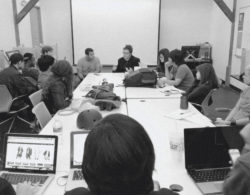
Austin and his students.
ERIN: Yeah. That’s a really good one. In the episode, I talk about the mistakes I’ve made as an owner, especially promoting people outside of their core skills, into management, for example. What a disaster that can be. Because you lose an amazing animator, and then you have this subpar manager. I think there has to be a conversation about it; when somebody is an amazing artist technician, they shouldn’t have to be moved into management to be compensated more.
Well, this has been a great tease on some of the episodes so far. Shall we finish discussing some work that’s inspired you throughout your careers?
ERIN: Well, you know how kids’ make mixtapes while listening to the radio? I used to do that on MTV with VHS tapes. I’d sit in my room and record A-ha videos and MTV bumpers. And it had nothing to do with music; I just always loved this medium.
There were some cool things coming out of the UK back in the day, some very experimental stuff.
MK-12 knocked everybody on their ass when they came out with 2D work that really utilized the 3D camera in After Effects. Kyle Cooper’s a genius, the work that RGA did with Kyle, Garson, Trollbäck and all those folk.
AUSTIN: I’d say for me, some of the early works that really inspired me was some of the early Psyop stuff. And actually, when I was a student, Kylie Matulick – one of the co-founders of Psyop – was the professor of my first “Intro to motion class.” She would bring in the stuff that they were doing in the really early days, and we’d watched it on VHS tapes. And I was just like, “what? This is crazy.” And then their Bombay Sapphire spot, it was just so… From an illustration and image-making point of view, just beautiful. And then the camera work and the perspective shifts were so cool.
When I was in grad school, I also remember seeing one of Brand New School’s early reels. It was… it was just fresh, and it was just design and fast moves and graphic. And I was like, “I want to work at that place.” And it took me three years to get booked there, but I did. In fact, I permalanced there for a year.
We want to thank Austin and Erin for sparing the time to talk to us. Check out Between the Keyframes for more insights on the history, present, and future of Motion Design.








